 Software Tutorial
Software Tutorial
 Office Software
Office Software
 How to use the if multiple function in Excel to create employee annual leave table
How to use the if multiple function in Excel to create employee annual leave table
How to use the if multiple function in Excel to create employee annual leave table
php editor Xigua is here to introduce to you how to use the if function in Excel to create an employee annual leave table. The if function is one of the most commonly used functions in Excel. It can judge and filter data based on certain conditions. When making an employee annual leave table, we can use the if function to determine whether the employee's number of leave days meets the annual leave requirements, and fill the results into the corresponding cells. Using the if function can save us time and energy and make making annual leave tables more efficient and accurate. Next, let’s discuss the specific operation methods together!
1. Clarify the relevant regulations and implementation rules for annual leave. That is, employees who have worked for 1 year but less than 10 years in total are entitled to 5 days of annual leave; employees who have been working for 10 years but less than 20 years are entitled to 10 days of annual leave; employees who have been working for 20 years or more are entitled to 15 days of annual leave. Under one of the special circumstances, annual leave cannot be taken.
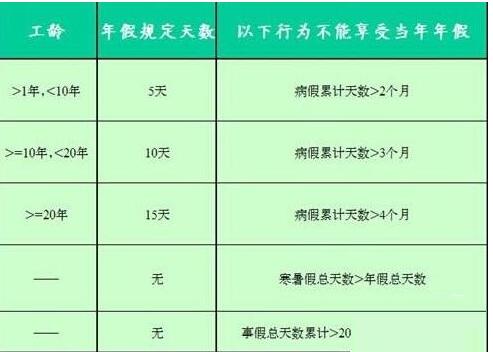
2. Create a new excel form and enter the form name, serial number, job number, name, gender, date of employment and other relevant information.
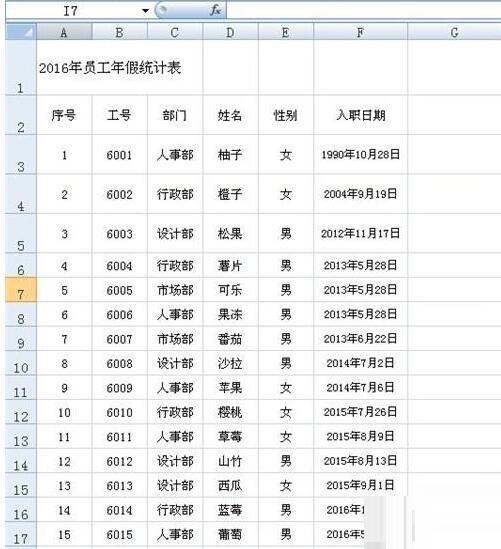
3. Enter [length of service (years)" in cell G2, enter the formula in cell G3: =DATEDIF(F3,TODAY(),"y"), and press [Return] Car/enter] can calculate the employee's length of service. Among them, the DATEDIF function is to calculate the corresponding value from the start date to the end date. In F3, the entry date is the starting time, TODAY() is the current date, and Y is the number of years of service .
After entering the formula, click with the mouse and when the symbol appears in the lower right corner of the G3 cell, drag it down to fill in the formula and calculate the length of service of all employees.
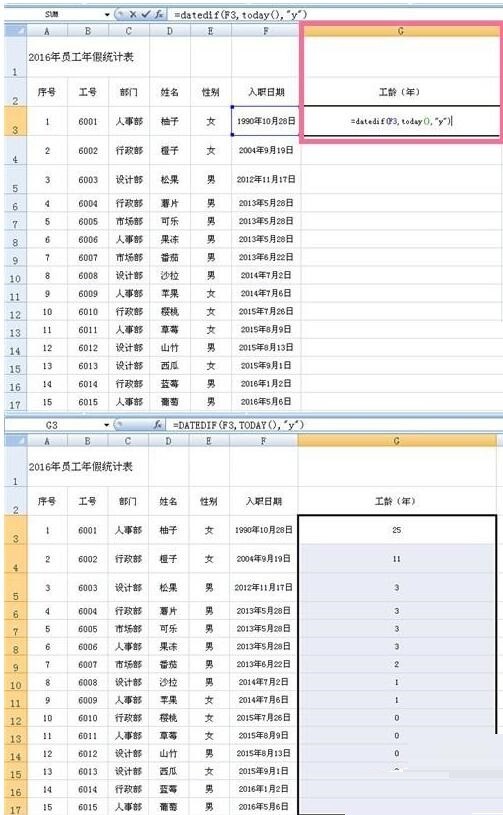
4. There are two algorithms for annual leave days.
The first one is to enter [annual leave days" in cell H2 and the formula in cell H3: =LOOKUP(G3,{0,1,10,20} ,{0,5,10,15}), press [Enter/Enter] to calculate the number of annual leave days for employees. Among them, the LOOKUP function is to find matching conditions and fill in the corresponding data. The array {0,1,10,20} refers to the node data in the length of service, and the array {0,5,10,15} is the number of annual leave days under the corresponding length of service. Braces {} can be entered using shift [/shift]. Note that in English mode, or after entering the formula, press CTRL SHIFT ENTER to complete.
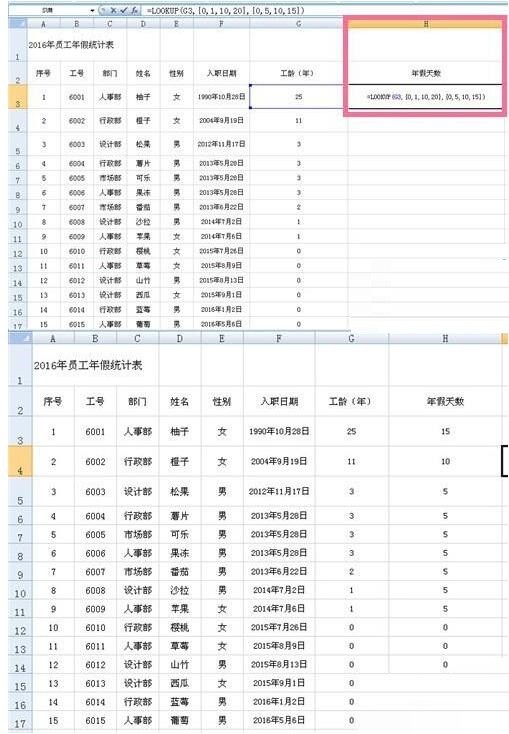
The second algorithm for annual leave days, enter the formula in cell H3: =IF(G3

5. Finally, in order to highlight the difference in annual leave days, you can select a format through [Conditional Formatting]-[Data Bar]. Then, by adjusting the font and alignment, the entire table is completed.
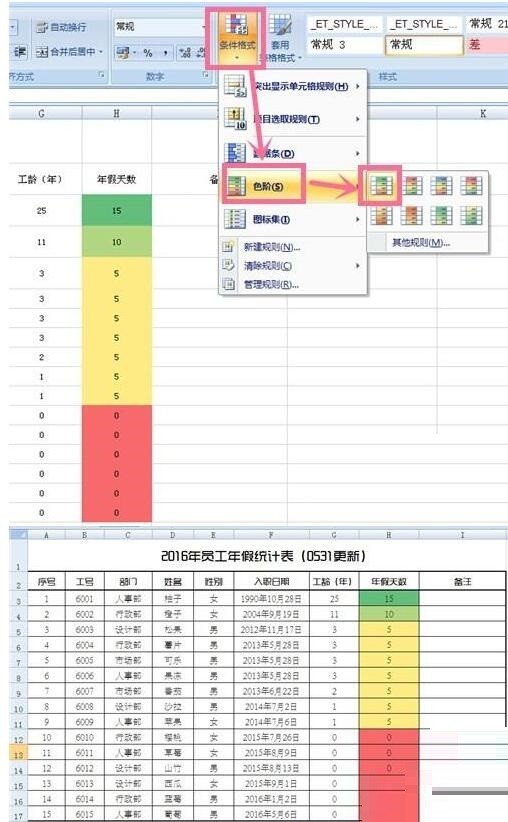
Note:
The braces {} in the array can be entered using shift [ and shift ]. Note that in English mode, or after entering the formula, press CTRL SHIFT ENTER to complete.
The above is the detailed content of How to use the if multiple function in Excel to create employee annual leave table. For more information, please follow other related articles on the PHP Chinese website!

Hot AI Tools

Undresser.AI Undress
AI-powered app for creating realistic nude photos

AI Clothes Remover
Online AI tool for removing clothes from photos.

Undress AI Tool
Undress images for free

Clothoff.io
AI clothes remover

AI Hentai Generator
Generate AI Hentai for free.

Hot Article

Hot Tools

Notepad++7.3.1
Easy-to-use and free code editor

SublimeText3 Chinese version
Chinese version, very easy to use

Zend Studio 13.0.1
Powerful PHP integrated development environment

Dreamweaver CS6
Visual web development tools

SublimeText3 Mac version
God-level code editing software (SublimeText3)

Hot Topics
 Your Calculator App Can Be Replaced By Microsoft Excel
Mar 06, 2025 am 06:01 AM
Your Calculator App Can Be Replaced By Microsoft Excel
Mar 06, 2025 am 06:01 AM
Ditch the Calculator: Why and How to Use Excel for All Your Calculations I haven't touched a calculator in ages. Why? Because Microsoft Excel handles all my calculations with ease, and it can do the same for you. Why Excel Trumps a Calculator While
 Don't Create Tables in Word: Use Excel Instead
Mar 06, 2025 am 03:04 AM
Don't Create Tables in Word: Use Excel Instead
Mar 06, 2025 am 03:04 AM
Creating tables in Word, although improved, is still cumbersome and sometimes brings more problems. This is why you should always create tables in Microsoft Excel. Why is it better to create tables in Excel? In short, Word is a word processor, while Excel is a data processor. So Word is not built for the best table creation, but its similar product, Excel. Here are just some of the reasons why creating tables in Excel is better than using Microsoft Word: Although it is surprising that you can use many Excel-like features in Microsoft Word tables, in Excel you
 How to Reduce the Gaps Between Bars and Columns in Excel Charts (And Why You Should)
Mar 08, 2025 am 03:01 AM
How to Reduce the Gaps Between Bars and Columns in Excel Charts (And Why You Should)
Mar 08, 2025 am 03:01 AM
Enhance Your Excel Charts: Reducing Gaps Between Bars and Columns Presenting data visually in charts significantly improves spreadsheet readability. Excel excels at chart creation, but its extensive menus can obscure simple yet powerful features, suc
 5 Things You Can Do in Excel for the Web Today That You Couldn't 12 Months Ago
Mar 22, 2025 am 03:03 AM
5 Things You Can Do in Excel for the Web Today That You Couldn't 12 Months Ago
Mar 22, 2025 am 03:03 AM
Excel web version features enhancements to improve efficiency! While Excel desktop version is more powerful, the web version has also been significantly improved over the past year. This article will focus on five key improvements: Easily insert rows and columns: In Excel web, just hover over the row or column header and click the " " sign that appears to insert a new row or column. There is no need to use the confusing right-click menu "insert" function anymore. This method is faster, and newly inserted rows or columns inherit the format of adjacent cells. Export as CSV files: Excel now supports exporting worksheets as CSV files for easy data transfer and compatibility with other software. Click "File" > "Export"
 How to Use the AVERAGEIF and AVERAGEIFS Functions in Excel
Mar 07, 2025 am 06:03 AM
How to Use the AVERAGEIF and AVERAGEIFS Functions in Excel
Mar 07, 2025 am 06:03 AM
Quick View of AVERAGEIF and AVERAGEIFS Functions in Excel Excel's AVERAGEIF and AVERAGEIFS functions can be used to calculate the average value of a dataset. However, unlike simpler AVERAGE functions, they are able to include or exclude specific values in the calculation. How to use the AVERAGEIF function in Excel Excel's AVERAGEIF function allows you to calculate the average value of a filtered dataset based on a single condition set. AVERAGEIF function syntax The AVERAGEIF function contains three parameters: =AVERAGEIF(x,y,z)
 Microsoft Excel Keyboard Shortcuts: Printable Cheat Sheet
Mar 14, 2025 am 12:06 AM
Microsoft Excel Keyboard Shortcuts: Printable Cheat Sheet
Mar 14, 2025 am 12:06 AM
Master Microsoft Excel with these essential keyboard shortcuts! This cheat sheet provides quick access to the most frequently used commands, saving you valuable time and effort. It covers essential key combinations, Paste Special functions, workboo
 How to Use LAMBDA in Excel to Create Your Own Functions
Mar 21, 2025 am 03:08 AM
How to Use LAMBDA in Excel to Create Your Own Functions
Mar 21, 2025 am 03:08 AM
Excel's LAMBDA Functions: An easy guide to creating custom functions Before Excel introduced the LAMBDA function, creating a custom function requires VBA or macro. Now, with LAMBDA, you can easily implement it using the familiar Excel syntax. This guide will guide you step by step how to use the LAMBDA function. It is recommended that you read the parts of this guide in order, first understand the grammar and simple examples, and then learn practical applications. The LAMBDA function is available for Microsoft 365 (Windows and Mac), Excel 2024 (Windows and Mac), and Excel for the web. E
 If You Don't Use Excel's Hidden Camera Tool, You're Missing a Trick
Mar 25, 2025 am 02:48 AM
If You Don't Use Excel's Hidden Camera Tool, You're Missing a Trick
Mar 25, 2025 am 02:48 AM
Quick Links Why Use the Camera Tool?





